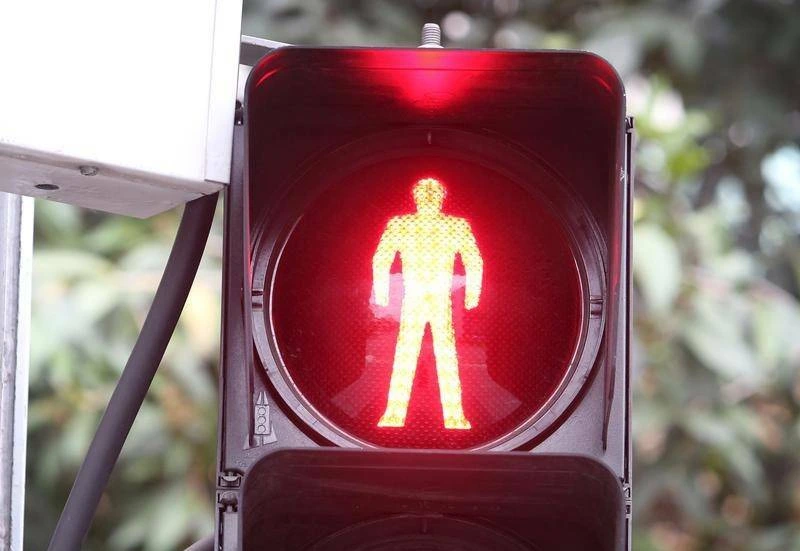Pedestrian signs are important elements of the complex choreography of urban traffic and quietly guide the movement of pedestrians in lively urban landscapes.
Often overlooked in the cacophony of horns and traffic lights, signals are central to the safety, efficiency, and accessibility of pedestrian navigation on busy streets.
A variety of pedestrian signals, from the iconic walk and don’t walk symbols to beeps and timers, serve as visual and audible language to guide people through urban intersections. Signals coordinated with traffic light cycles are not only static indicators but also dynamic components that are crucial for the smooth integration of pedestrians into urban traffic.
Green light : Pedestrian Markings
In the field of pedestrian signals, the pedestrian signal is an iconic symbol, commonly known as a green light, that allows pedestrians to cross the street safely. Its counterpart, a flashing no-walk sign adorned with an orange or flashing red hand, indicates that pedestrians should refrain from starting across the street. These signals work in conjunction with the start counter and provide pedestrians with important information about the remaining time before the signal changes. This integration of visual and temporal elements improves both safety and efficiency in the pedestrian experience.
Audio tags represent a significant leap forward in inclusion and meeting the needs of the visually impaired. These signals emit discrete sounds or messages that communicate the status of the pedestrian signal and ensure that visually impaired people can cross intersections safely. The inclusion of buttons gives pedestrians the extra power to activate the walk signal when they are ready to cross. These tactile interactions promote more inclusive and accessible urban environments and promote independence for people with disabilities.
In urban planning, pedestrian marking is an integral part of the complex tapestry of urban infrastructure. In addition to improving safety, pedestrian signs play a key role in traffic management. Signals coordinated with traffic light cycles optimize the movement of both pedestrians and vehicles and ensure harmonious coexistence in shared spaces. Strategically placed pedestrian signs along with well-marked intersections promote the total accessibility of urban landscapes. Their placement and visibility were carefully considered in the urban planning process to create spaces where pedestrians can move safely and without unnecessary obstacles.

The technology behind pedestrian signals has evolved significantly over the years, contributing to their effectiveness in modern urban environments. Advanced traffic management systems organize the synchronization of pedestrian signals with traffic lights, which optimizes both vehicle and pedestrian traffic. The advent of sensor-equipped smart crosswalks marks a new frontier where technology dynamically adjusts signal timing based on pedestrian patterns in real-time. Light-emitting diode (LED) technology has revolutionized the visibility of pedestrian signals by providing bright, energy-efficient, and long-lasting indicators that increase safety, especially in the dark.
In today’s urban landscape, pedestrian signals are not isolated entities but interconnected parts of a smart urban infrastructure. These signals interact with other systems such as traffic cameras and sensors, creating a responsive and dynamic environment. Emerging technologies explore the integration of artificial intelligence and machine learning to further improve the adaptability and effectiveness of pedestrian signals, aligning them with the broader goals of creating smart and responsive urban spaces.
Effectiveness
The role of pedestrian signs continues to evolve in modern cities, adapting to the changing dynamics of urban life. Dynamic pedestrian signals, which respond to pedestrian patterns and traffic conditions in real-time, are becoming more common, ensuring that signals are not static but adapt to the ebb and flow of city life. Pedestrian initiatives are gaining momentum by prioritizing safe and convenient crossings, improving signal visibility, and reducing wait times. Integrating pedestrian signage into wider multimodal transport networks is consistent with the overall goal of creating a sustainable and accessible urban environment.
There are still challenges to ensuring the effectiveness of pedestrian signs. Pedestrian behavior remains an important factor and educational campaigns are essential to promote sign compliance. Adequate investment in pedestrian infrastructure, including well-maintained signage, pedestrian crossings, and barrier-free access roads, is crucial to creating a pedestrian-friendly urban space. As cities struggle with the demands of increasing population density and urbanization, the role of pedestrian signage in shaping the urban landscape becomes even more critical.
Conclusion
In summary, pedestrian signs act as silent sentinels in the urban environment and guide pedestrians through the complexities of urban life. Their evolution from simple symbols to complex, interconnected systems reflects a commitment to creating safer, more efficient, and more accessible cities. As technology advances and urban areas change, pedestrian signage remains at the forefront of urban planning, ensuring a harmonious coexistence of pedestrian and vehicular traffic. Prioritizing investments in pedestrian infrastructure and leveraging technical innovation are critical to fostering environments that prioritize pedestrian safety and well-being in a changing urban landscape.
